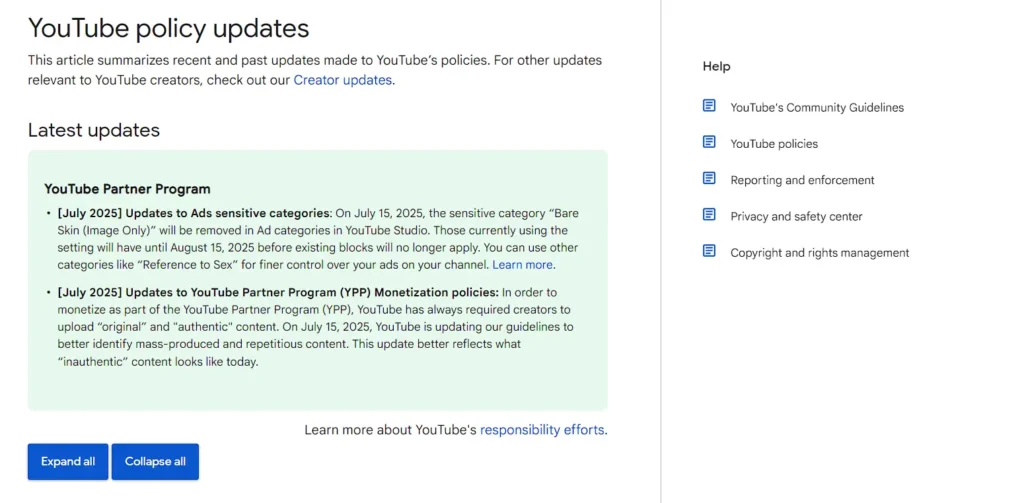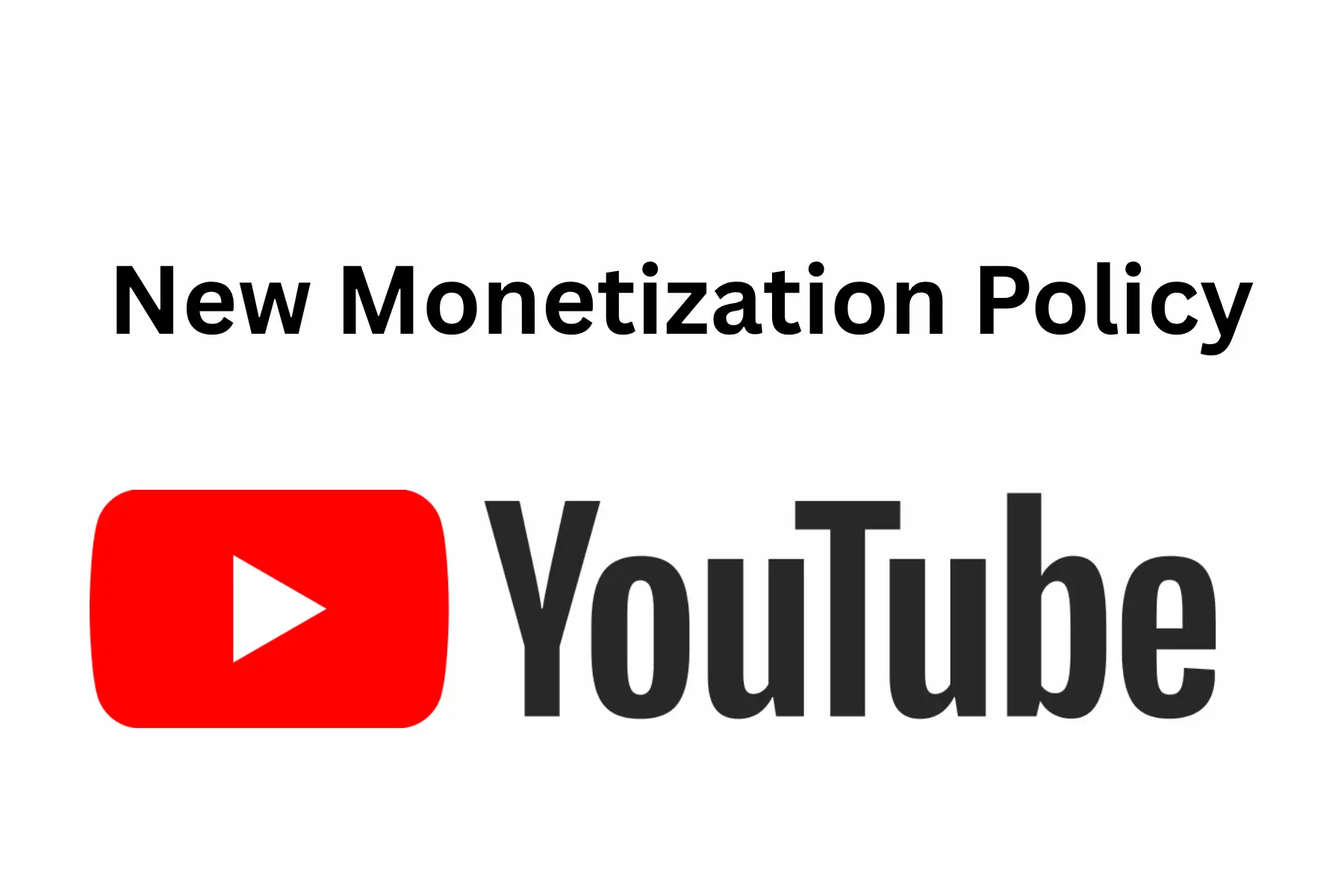YouTube’s monetization policy is going through major changes in 2025, as the platform cracks down on repetitive, low-effort, and reuploaded content. With this shift, YouTube aims to prioritize originality and meaningful viewer engagement, reshaping how creators qualify for revenue under the YouTube Partner Program (YPP)
YouTube Monetization Policy Updates Effective from July ’25
YouTube has announced a stricter crackdown on channels uploading low-effort, repetitive, or reuploaded content, reinforcing its push for originality in the creator ecosystem. It’s a big shift in how YouTube handles monetization under the YouTube Partner Program (YPP), with big implications for creators relying on volume rather than value.
YouTube announced the new enforcement parameters via a bulletin on its platform-wide policy updates page, clarifying that creators must now publish “original” and “authentic” videos to qualify for revenue under the YouTube Partner Program (YPP). Posted in early July, the update builds on standards outlined in YouTube’s channel monetization policies, emphasizing that content must be transformed significantly—“not be duplicative or repetitive”—and offer genuine educational or entertainment value to audiences .

Additional Details from the Policy:
- Effective July 15, 2025, YouTube will more precisely define “mass-produced” and “repetitious” content in its YPP guidelines, ensuring creators can better understand what’s disallowed.
- The policy clarifies that “repetitious content refers to videos so similar viewers may struggle to tell them apart,” and templates or low-variation uploads are ineligible for monetization.
- Reused content—videos that repurpose others’ material without substantive original input—also risks demonetization unless creators add significant commentary, editing, or context.
YouTube Monetization Policies for Shorts
The YouTube monetization policies for Shorts have undergone a major transformation as well in 2025, providing creators with new earning opportunities while enforcing stricter standards for originality and compliance. Under the latest updates,
Now, Shorts creators get to earn from ads that appear between videos in the Shorts feed, as well as from YouTube Premium subscription revenue. YouTube distributes this income through a shared revenue model: 45% of the total ad revenue pool—after music licensing costs—is allocated to eligible creators based on their share of total Shorts views. This change reflects YouTube’s growing commitment to short-form content and its competitiveness with platforms like TikTok and Instagram Reels.
To qualify for monetization, creators must first be accepted into the YouTube Partner Program (YPP). As per the current YouTube monetization policies, there are two eligibility paths: one is achieving 1,000 subscribers along with 10 million valid public Shorts views in the last 90 days; the other is meeting the older long-form requirement of 4,000 valid public watch hours over the past 12 months with 1,000 subscribers. Once eligible, creators must manually accept the Shorts Monetization Module in their YouTube Studio under the “Earn” section to begin receiving payouts from Shorts ads and Premium engagement.
YouTube places strong emphasis on content originality and rights ownership when evaluating Shorts for monetization. Videos that are considered repetitious, low-effort, or overly templated will not be eligible for revenue sharing. For example, Shorts that recycle the same premise across multiple uploads, re-upload third-party content without significant transformation, or use AI-generated footage without added commentary or context are likely to be demonetized. Additionally, YouTube’s Content ID system flags any unlicensed use of copyrighted music or video clips, making it crucial for creators to either use royalty-free tracks or properly licensed assets. Even a single Content ID claim on a Shorts video longer than one minute can result in it being blocked globally and disqualified from monetization.
In terms of ad suitability, YouTube’s standard advertiser-friendly guidelines fully apply to Shorts. Videos must avoid inappropriate language, violence, and misleading claims to remain monetized. Creators can check the monetization status of their Shorts using the green/yellow icons in the Studio dashboard and may request a manual review if content is flagged unfairly. YouTube Premium revenue is calculated based on the creator’s share of total Shorts watch time from Premium users in a given country, ensuring that regional engagement influences payouts. This makes content localization and audience targeting even more important for creators looking to grow earnings.
Overall, the 2025 updates to YouTube monetization policies for Shorts aim to reward creators who produce unique, engaging, and policy-compliant content. While the barrier to entry remains manageable, ongoing monetization requires creators to focus on quality, rights management, and originality. This marks a significant step in YouTube’s strategy to professionalize the Shorts ecosystem and make short-form content a sustainable income stream for digital creators worldwide.
What’s Changing — And Why It Matters
In an official update posted to YouTube’s policy update tracker, the platform emphasized that content creators must now meet higher standards for originality, value, and viewer experience to qualify for ad revenue.
This move is not about introducing a new policy, but rather about enforcing existing guidelines with greater rigor and improved AI detection tools. YouTube stated that while repetitive and mass-produced content was always technically ineligible for monetization, many violators slipped through due to lenient or inconsistent enforcement.
“Your content should offer genuine educational or entertainment value — not just exist to farm views,” the updated policy reads.
Who’s Affected? Think Copy-Paste Creators & Content Farms
The updated enforcement is expected to impact a wide range of creators including:
- Shorts spammers who mass-upload templated vertical clips
- Channels reusing third-party content without meaningful transformation
- Low-effort “reaction” or “listicle” formats that lack commentary or creativity
Among those under the microscope are viral Shorts creators like New Man Magic, known for reuploading the same videos under slightly altered titles to promote the “VitaWear Smart Band,” and Oren Shorts, whose top-viewed clips often repeat identical setups with mobile game visuals and generic captions.
And yet, these channels still rack up millions of views every month, offer little originality and have long exploited gaps in YouTube’s content recognition systems.
The Bigger Picture: Shorts Boom, Spam Surge
YouTube has been aggressively pushing Shorts, its vertical video format meant to rival TikTok. At the Cannes Lions 2025, CEO Neal Mohan revealed that Shorts now average over 200 billion daily views — a staggering number.
But with growth comes a darker side: Short-form content farms, AI-generated clips, and repetitive uploads have flooded the platform, degrading user experience and advertiser trust.
By clamping down on low-quality uploads, YouTube hopes to:
- Protect ad inventory quality
- Uplift authentic creators
- Improve overall viewer trust
This aligns with broader efforts from parent company Google to maintain content integrity across its platforms.
What YouTube Now Expects from Creators
If you’re a content creator aiming to stay monetized, here’s what’s now essential:
| Requirement | Description |
|---|---|
| Originality | Content must be self-created or significantly transformed |
| Viewer Value | Videos should inform, entertain, or engage authentically |
| Avoid Repetition | Repetitive uploads with minimal variation are disqualified |
| Proper Attribution | Use of third-party content must follow fair use or licensing |
| No Spam or Clickbait | Misleading thumbnails/titles can lead to demonetization |
If you’re reusing content, you’ve gotta make big changes to it — simply re-editing or slicing clips no longer meets the bar for monetization.
Expert Take: Not Just Reaction Channels in Danger
While the reaction video genre has often faced criticism for riding on the backs of original creators, YouTube insiders suggest this update is more targeted at Shorts abuse and AI-generated spam.
“This isn’t an attack on commentary or reaction formats per se — it’s about eliminating content that’s mass-generated for views without effort or value,” said a senior content strategist at a top MCN.
Why This Matters for the Creator Economy
This move could reset expectations across the YouTube creator landscape:
- Smaller, spam-driven channels may find monetization impossible
- Original content creators may benefit from improved visibility and revenue share
- Agencies and AI content tools face new pressure to adapt to YouTube’s evolving standards
It also signals a trend: platforms like TikTok, Instagram Reels, and YouTube are beginning to prioritize quality over quantity in the arms race for creator attention.
Will Your Channel Be Affected? Review Monetization Guidelines
Not necessarily — if you’re creating original, thoughtful content, you’re safe. However, if your strategy involves reusing viral clips, generic gameplay overlays, or AI-narrated trivia dumps — it’s time to rethink.
Creators can review the full monetization guidelines here and follow updates via Team YouTube’s X account.
Final Thoughts
YouTube’s stricter monetization policy is a strong signal: quality is king. As the platform grows, so does the need to protect both advertisers and viewers from low-value, copy-paste content. This enforcement wave could finally clear the fog of junk uploads and let creative, authentic voices shine.
For serious creators, this is not a threat — it’s a timely opportunity.
Stay Ahead of the Algorithm
Subscribe to our newsletter for weekly updates on YouTube, creator policies, digital tools, and platform shifts affecting content creators worldwide.
Frequently Asked Questions (FAQs) – YouTube Monetization Policy Update 2025
1. What is the latest update to the YouTube monetization policy in 2025?
As of July 15, 2025, YouTube has updated its monetization policy to restrict repetitive, low-effort, or reused content. Creators must now provide original content that delivers educational or entertainment value to qualify for the YouTube Partner Program (YPP).
2. What does YouTube mean by “repetitive” or “mass-produced” content?
“Repetitive” content includes videos with nearly identical formats, concepts, or templates, often lacking originality. “Mass-produced” videos are typically created using automated tools or reused footage without meaningful changes, making them ineligible for monetization.
3. How does the 2025 YouTube monetization policy affect Shorts creators?
Shorts creators must ensure originality to earn ad revenue. While monetization from ads and YouTube Premium still applies, AI-generated or templated Shorts without transformation will be demonetized under the new rules.
4. Are reused or third-party videos still allowed under YouTube’s monetization policy?
Yes, but only if significantly transformed. Creators must add commentary, edits, or context. Re-uploading raw clips or minimal edits no longer qualifies for monetization.
5. What are the new eligibility requirements for Shorts monetization under YPP?
To monetize Shorts in 2025, you must have:
- 1,000 subscribers and 10 million valid public Shorts views in the last 90 days, or
- 1,000 subscribers and 4,000 valid public watch hours in the last 12 months.
Also, you must accept the Shorts Monetization Module in YouTube Studio to start earning.
6. What kinds of content will no longer qualify for monetization under YouTube’s 2025 policy?
Examples of now ineligible content include:
- Generic reaction videos without commentary
- AI-narrated listicles
- Gameplay videos without original input
- Spammy or mass-uploaded Shorts
7. How can I make sure my channel stays compliant with the new YouTube monetization policies?
Create original, engaging videos with clear editorial input. Avoid automation, ensure proper licensing for music/visuals, and regularly review YouTube’s official monetization guidelines and policy updates.

